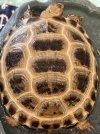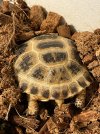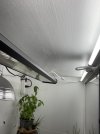"W" Family
Member


How do we know if we need to limit food? Sometimes I am concerned that my little guy looks a little puffy out of his shell. I think his growth is looking good as the white I assume is the growth. We got him in October and he has gained 2.5 ounces and almost an inch in width and length since getting him. So he is approximately 7 months old. He has been shedding under his neck and front legs lately so I guess that is another sign of growth. In his enclosure he has the UV light that comes on 3 hours a day, LED Strip lights for daylight, and CHE for heat on a thermostat. I spray his cage daily to keep substrate moist and he get a 30 minute bath in the morning daily. He eats spring mix, romaine, collard greens and matsuri (2 pellets daily). He has cat grass, pathos and rattlesnake plant that he munches on too growing in his enclosure. I think I finally have it down but please let me know if I need to adjust something or suggestions in any way.
